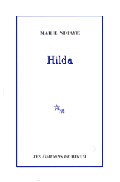Hilda
 Marie NDiaye, Hilda, Paris, Éditions de Minuit, 1999, 96 p.
Marie NDiaye, Hilda, Paris, Éditions de Minuit, 1999, 96 p.
« Mme Lemarchand - Que voulez-vous ?
Frank - Je suis Meyer. Les petits travaux. On m’a dit de me présenter aujourd’hui.
Mme Lemarchand - Oui, oui… Mais, finalement, monsieur Meyer, finalement, peu importe les petits travaux. Je me suis laissé dire que vous avez une femme qui ferait mon affaire. J’espère que votre femme est disponible, j’espère qu’elle est courageuse et dure à la tâche, et propre, propre surtout. Je ne supporte pas autour de moi ce qui ressemble, de près ou de loin, à du laisser-aller. Mais on m’a dit que votre femme est propre et vaillante et qu’elle s’appelle Hilda. »
(Extrait de l’incipit, Editions de Minuit, 1999.)
Documentation critique
RUNDLE, Erika, « Translating Marie NDiaye », PAJ : a Journal of Performance & Art, vol. 28 (janvier 2006), p. 78-81. +++ Article de revue
###Résumé
« The article focuses on Erika Rundle’s translations of Marie NDiaye’s play titled “Hilda”. The transition from fiction to drama requires a thorough reorientation of the writer’s imagination to accommodate the rigors and freedoms of theatre. The play has been translated and performed throughout Europe. »
GEIGER, Marion, « Parole et pouvoir : la part totalitaire dans Hilda de Marie NDiaye », French Review: Journal of the American Association of Teachers of French, n° 84, n° 1 (octobre 2010), p. 3, 114-126. +++ Article de revue
CHOPLIN, Olivia J., « Staging the Psyche: Representing the ‘Other Scene’ in the Theater of Michel Tremblay, Marie NDiaye and Wajdi Mouawad », thèse de doctorat, depatment of French and Italian, Emory University, 2009, 186 f. +++ Thèse de doctorat / mémoire de maîtrise
### Abstract
This dissertation examines the possibilities of and the meaning of theater in the wake
of the discovery of the unconscious. By exploring the ways in which three contemporary
Francophone authors have created innovative and evocative theatrical representations of the
dramas that unfold in the mind, it contributes to the discussion of several questions. How
does our contemporary understanding of the unconscious change the ways in which
playwrights use theatrical space? What is the function of theater for the spectator and for
society, most particularly in the contemporary French and Francophone context? Why does
theater still attract spectators despite the fact that contemporary visual culture offers
numerous other creative outlets both for spectators and artists?
The first chapter explores the theoretical links between psychoanalysis and theater via
a discussion of shared terms and an analysis of the theatrical metaphors that have been
present in psychoanalytic discourse since its origins with Freud. The subsequent chapters
analyze three playwrights who have integrated the concept of psychic space into their
writings, using the theatrical space to stage metaphors for the otherwise invisible actions of
the mind. Chapter two discusses two plays by Québécois playwright Michel Tremblay, À toi,
pour toujours, ta Marie-Lou and Le vrai monde?, arguing that the use of mise en abyme
structures demonstrates metaphorically the ways in which Tremblay’s characters experience
psychic distress. Chapter three addresses French playwright Marie NDiaye’s first theatricalwork, Hilda. It argues that the absence of the title character from the stage becomes ametaphor for the destructive fantasy structure that eventually removes her from her own life.
The final chapter analyzes the embodiments of dreams on the stage in Lebanese-Québécois
playwright Wajdi Mouawad’s Littoral. Charting the trajectory of the play’s main character,
Wilfrid, from living within his own mind to living within the world, it points to the necessity
of the encounter with “the other” in order to come to an understanding of the self.
By representing both directly and metaphorically the disastrous effects of
unconscious living, Tremblay, Ndiaye and Mouawad plead for conscious recognition of the unconscious structures that can govern our lives.
La version PDF de la thèse est disponible pour les membres de communautés universitaires qui ont un abonnement institutionnel auprès de UMI - Proquest ###
LINDLEY, Elizabeth, « The Monstruous Female : Images of Abjection in Marie NDiaye’s Hilda », dans Amaleena DAMLÉ et Aurélie L’HOSTIS (dir,), The Beautiful and the Monstrous: Essays in French Literature, Thought and Culture, Berne, Peter Lang, 2010, p. 181-195. +++ Chapitre de collectif
| Hilda (oeuvre) | |
|---|---|
| Titre | Hilda |
| Auteur | Marie NDiaye |
| Parution | 1999 |
| Tri | Hilda |
| Afficher | oui |